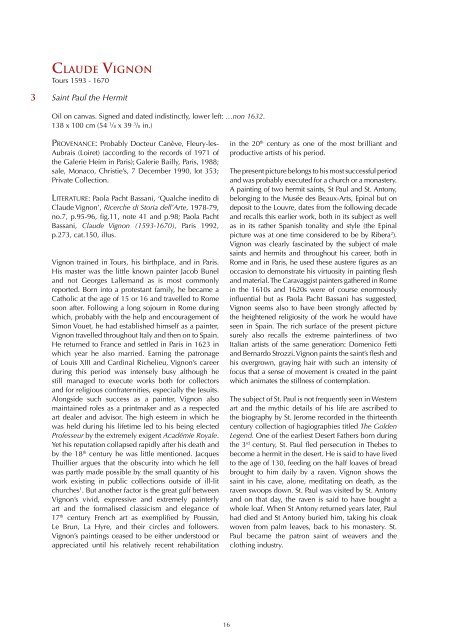Create successful ePaper yourself
Turn your PDF publications into a flip-book with our unique Google optimized e-Paper software.
Claude Vignon<br />
Tours 1593 - 1670<br />
3<br />
Saint Paul the Hermit<br />
Oil on canvas. Signed and dated indistinctly, lower left: …non 1632.<br />
138 x 100 cm (54 3 /8 x 39 3 /8 in.)<br />
Provenance: Probably Docteur Canève, Fleury-les-<br />
Aubrais (Loiret) (according to the records of 1971 of<br />
the Galerie Heim in Paris); Galerie Bailly, Paris, 1988;<br />
sale, Monaco, Christie’s, 7 December 1990, lot 353;<br />
Private Collection.<br />
Literature: Paola Pacht Bassani, ‘Qualche inedito di<br />
Claude Vignon’, Ricerche di Storia dell’Arte, 1978-79,<br />
no.7, p.95-96, fig.11, note 41 and p.98; Paola Pacht<br />
Bassani, Claude Vignon (1593-1670), Paris 1992,<br />
p.273, cat.150, illus.<br />
Vignon trained in Tours, his birthplace, and in Paris.<br />
His master was the little known painter Jacob Bunel<br />
and not Georges Lallemand as is most commonly<br />
reported. Born into a protestant family, he became a<br />
Catholic at the age of 15 or 16 and travelled to Rome<br />
soon after. Following a long sojourn in Rome during<br />
which, probably with the help and encouragement of<br />
Simon Vouet, he had established himself as a painter,<br />
Vignon travelled throughout Italy and then on to Spain.<br />
He returned to France and settled in Paris in 1623 in<br />
which year he also married. Earning the patronage<br />
of Louis XIII and Cardinal Richelieu, Vignon’s career<br />
during this period was intensely busy although he<br />
still managed to execute works both for collectors<br />
and for religious confraternities, especially the Jesuits.<br />
Alongside such success as a painter, Vignon also<br />
maintained roles as a printmaker and as a respected<br />
art dealer and advisor. The high esteem in which he<br />
was held during his lifetime led to his being elected<br />
Professeur by the extremely exigent Académie Royale.<br />
Yet his reputation collapsed rapidly after his death and<br />
by the 18 th century he was little mentioned. Jacques<br />
Thuillier argues that the obscurity into which he fell<br />
was partly made possible by the small quantity of his<br />
work existing in public collections outside of ill-lit<br />
churches 1 . But another factor is the great gulf between<br />
Vignon’s vivid, expressive and extremely painterly<br />
art and the formalised classicism and elegance of<br />
17 th century French art as exemplified by Poussin,<br />
Le Brun, La Hyre, and their circles and followers.<br />
Vignon’s paintings ceased to be either understood or<br />
appreciated until his relatively recent rehabilitation<br />
in the 20 th century as one of the most brilliant and<br />
productive artists of his period.<br />
The present picture belongs to his most successful period<br />
and was probably executed for a church or a monastery.<br />
A painting of two hermit saints, St Paul and St. Antony,<br />
belonging to the Musée des Beaux-Arts, Epinal but on<br />
deposit to the Louvre, dates from the following decade<br />
and recalls this earlier work, both in its subject as well<br />
as in its rather Spanish tonality and style (the Epinal<br />
picture was at one time considered to be by Ribera 2 ).<br />
Vignon was clearly fascinated by the subject of male<br />
saints and hermits and throughout his career, both in<br />
Rome and in Paris, he used these austere figures as an<br />
occasion to demonstrate his virtuosity in painting flesh<br />
and material. The Caravaggist painters gathered in Rome<br />
in the 1610s and 1620s were of course enormously<br />
influential but as Paola Pacht Bassani has suggested,<br />
Vignon seems also to have been strongly affected by<br />
the heightened religiosity of the work he would have<br />
seen in Spain. The rich surface of the present picture<br />
surely also recalls the extreme painterliness of two<br />
Italian artists of the same generation: Domenico Fetti<br />
and Bernardo Strozzi. Vignon paints the saint’s flesh and<br />
his overgrown, graying hair with such an intensity of<br />
focus that a sense of movement is created in the paint<br />
which animates the stillness of contemplation.<br />
The subject of St. Paul is not frequently seen in Western<br />
art and the mythic details of his life are ascribed to<br />
the biography by St. Jerome recorded in the thirteenth<br />
century collection of hagiographies titled The Golden<br />
Legend. One of the earliest Desert Fathers born during<br />
the 3 rd century, St. Paul fled persecution in Thebes to<br />
become a hermit in the desert. He is said to have lived<br />
to the age of 130, feeding on the half loaves of bread<br />
brought to him daily by a raven. Vignon shows the<br />
saint in his cave, alone, meditating on death, as the<br />
raven swoops down. St. Paul was visited by St. Antony<br />
and on that day, the raven is said to have bought a<br />
whole loaf. When St Antony returned years later, Paul<br />
had died and St Antony buried him, taking his cloak<br />
woven from palm leaves, back to his monastery. St.<br />
Paul became the patron saint of weavers and the<br />
clothing industry.<br />
16
















